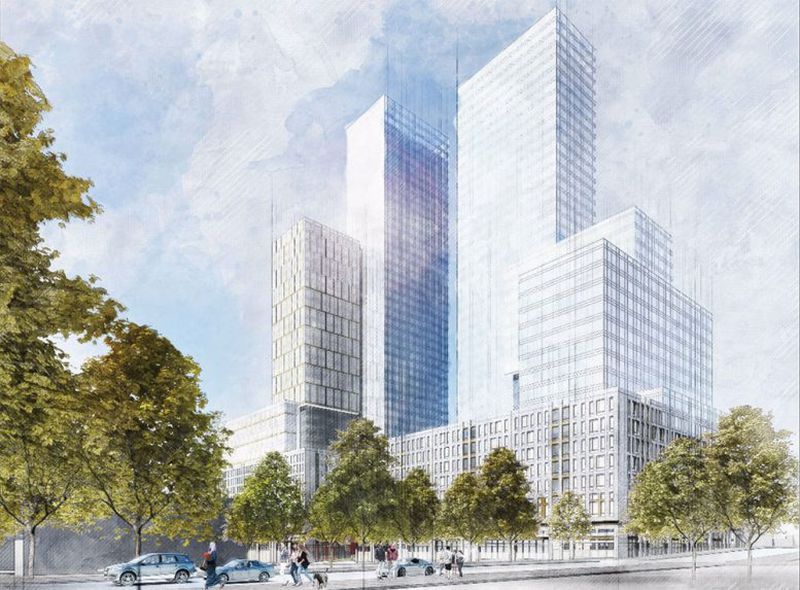An otherwise year rocky year is ending on a celebratory note for the Brooklyn Botanic Garden (BBG) and community activists in the borough’s Crown Heights.
On Monday, New York City Mayor Bill de Blasio came out in opposition of a planned mixed-use development project anchored by two 39-story residential towers closely flanking the southeastern edge of the garden’s 52 wedge-shaped acres. In effect, the mayor has now effectively squashed the development in its current form.
Located at the site of an old spice factory, the 1.4 million-square-foot mega-development—a project of Bruce Eichner’s Continuum Company—has been hotly contested from the get-go. The BBG and its supporters have voiced concerns that the 400-foot-tall-plus towers anchoring the 960 Franklin development would cast colossal shadows across the garden, blocking sunlight and harming the 110-year-old institution’s prized collections. Anti-gentrification campaigners and community members argued that it would also disrupt the character of the neighborhood and lead to displacement.
“Today, I am voicing my opposition to the proposed 960 Franklin development in Crown Heights that would harm the research and educational work carried out by one of this city’s prized cultural institutions, the Brooklyn Botanic Garden,” de Blasio said in a statement to Gothamist, which first reported the news.

De Blasio also referred to the development as “grossly out of scale.” In February of this year, a year after plans for 960 Franklin were first publicly unveiled, the mayor assumed a (vocally) friendly stance with regard to the project. Meanwhile, local opposition continued to swell. Now, as 2020 comes to a close, de Blasio, who just ten months ago told WNYC’s Brian Lehrer in an interview that “I don’t think it [the development] ruins the garden forever,” has kindly requested that “the developers go back to the drawing board and create a proposal that we can be proud of.”
Per the New York Post, the mayor’s office later claimed that during the February 7 interview Blasio had conflated 960 Franklin with another nearby rezoning/development scheme with a smaller footprint and squatter towers headed by another developer. Coincidentally, the rezoning certification for that project was reversed yesterday in a legal ruling by Brooklyn Supreme Court Judge Reginald Boddie.
In the summer of 2019, the BBG staged an exhibition, Fight For Sunlight, detailing the potentially catastrophic impact that the project would have if allowed to move forward. A shadow analysis conducted by the BBG found that the towers could block up to four hours of crucial daily sunlight to the multitude of greenhouses, nurseries, and conservatories clustered in the eastern section of the garden. Given that the impacted conservatory section is where the entirety of the garden’s plants—including rare and endangered species—are propagated and grown, an extended daily blotting out of the sun would “threaten the entirety of the collection, both indoors and out” according to the BBG campaign.
“On the shortest darkest day of the year, this is a big blast of sunlight in every sense,” Adrian Benepe, the newly instated president of the Brooklyn Botanic Garden and a former City Parks commissioner, told Gothamist. “Today is a solstice and we’ve been fighting for sunlight for more than a year.”
“While we are cautiously optimistic about this news, we will remain vigilant in opposing any zoning changes that will harm the Garden,” wrote the BBG in a campaign update.
Housing activists and community members led by grassroots groups including Alicia Boyd’s Movement to Protect the People also declared victory following de Blasio’s about-face. While inside the garden there was grave concern about the development wreaking havoc on its collection, outside the garden, local residents worried about the havoc 1,578 new residential units would wreak on the low-slung community. The towers would have been made possible by a rezoning application submitted by Continuum that would have reversed restrictions instituted in 1991 that limit the height of buildings bordering the BBG to six or seven stories. In addition to physically altering the neighborhood and being, as mentioned by de Blasio “grossly out of scale,” the development sparked fear of accelerated gentrification.
Half of 960 Franklin’s units would have rented for below-market rate—a fact touted by the developers as a much-needed boon for a city in a dire need of additional affordable housing. But as noted by Gothamist, lower-income local residents still would have been priced out according to opponents.
The BBG has stated that is “categorically not” opposed to affordable housing and that it “is keenly aware of the affordability crisis faced by New Yorkers, including many in rapidly gentrifying neighborhoods like ours, Crown Heights, where median incomes would not qualify most residents for even the lowest tier of the affordability index used for the proposed development.”
In November, Movement to Protect the People filed a lawsuit in Brooklyn Supreme Court in an effort to halt the development. The group also led the charge in successfully stopping the rezoning plans at the other aforementioned Crown Heights high-rise development site, which was not opposed by the BBG.
AN has reached out to the developers for comment and will update this article if we hear back.











